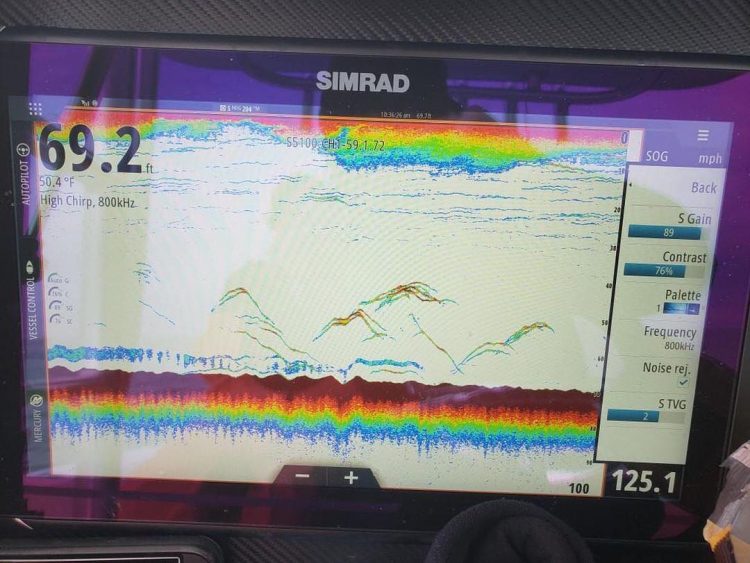What’s the right transducer for my boat?
As fish-finding technology has advanced, the number of decisions fishermen must make when setting up marine electronics has multiplied. However, consider these choices a blessing – they represent an opportunity to create a specialized system that best fits your fishing needs.
Transducers are the eyes (or more accurately, the ears) of your fishfinder. They send energy waves out into the water column and receive the echoes, providing the information that is ultimately displayed on your fishfinder’s screen. Transducers no longer come in a one-size-fits-all option. Instead, fishermen can choose among several variables and select one or more transducers that work best for them.
If you’re shopping for a transducer for a new hull or updating the electronics on your boat, the question you should be asking isn’t “What transducer fits my boat?” It’s “What transducer fits my fishing?”
“Before we talk about what boat you have, what we want to know is, what are you trying to do?” explained Craig Cushman, director of marketing for Airmar Technology, a primary source for marine transducers. “We want to know where you are fishing and what are you fishing for. Then we can decide what transducer frequency is best and what transducer power output is best. The last piece of the puzzle is how it attaches to your particular boat.”
What depths are you fishing?
“If we know what depths a fisherman will be fishing, we can determine what power output they need,” said Cushman. “For most anglers in the Northeast, we end up recommending a 1kW transducer. That’s plenty of power for the anger who fishes mostly inshore waters for fish like stripers and fluke, and occasionally runs offshore to fish deep water up to 1500 feet.
“if a fisherman specializes in really deep-water fishing, say, they do a lot of daytime swordfishing in depths of 3,500 to 6,000 feet, then we’d recommend a more powerful transducer.”

What kind of fishing are you doing?
“Once we establish the power output, we ask, ‘When you’re out on the water, what kind of fishing are you doing?’” said Cushman. “Are you looking for fish holding tight to the bottom, or tight to structure, like a wreck? Or are you looking for fish in the water column, like striped bass, bluefish, and schools of bait? The answer determines what frequency and beamwidths will be most useful.”
High frequencies provide greater detail at shallower depths. This can be useful for separating fish holding tight on drop-offs, wrecks, or reefs. A lower frequency will achieve greater depth, but it will not give you same target resolution. Low frequencies will show schools of small fish (such as sand eels or squid) without separating them into individual targets.
“For most fishermen in the Northeast, medium frequencies are just right. That’s why our B-175 medium transducer is always a good choice,” said Cushman. The B-175 medium delivers up to 50 kHz of total bandwidth (85-135 kHz) in just one installation. This enables bottom detection down to 1,500 feet with excellent detail and resolution.
Midsize center console fishermen who regularly fish offshore might opt for a combo transducer, like the B275LHW. This is a wide-beam chirp-ready transducer that offers a high frequency range of 150-250 kHz with a constant 25° beam width, along with a low frequency that chirps from 42 kHz to 65 kHz. This combo is perfect for searching the upper water column for pelagics and having the wide coverage for the deeper depths too.
“Fishermen can use both at same time, or choose one over the other,” said Cushman. “It all comes down to picking the right tool for the scenario.”

What kind of boat are you running?
“Once we know where our customer is fishing, we know what power they need. When we know what techniques they are employing, we can determine the best frequencies. The third question is, what kind of boat are they running? That will determine how we attach the transducer to their boat,” explained Cushman.
For example, on a boat with twin screws, you should avoid a transom mount, as there would be too much turbulence. Typically, the best option is to get forward of the props, on the hull, as close to centerline as possible, where you are most likely to have non-aerated water. Bubbles and turbulence are the enemy of clear sonar performance. Always think about finding the “cleanest” water when choosing the right location for installation on a hull.

Case Study: Setting up the On The Water boat
This winter, On The Water worked with Airmar and Simrad to set up the marine electronics on our television boat, a 32 Regulator center console. Airmar suggested mounting two transducers:
The B-275-LHW (low-high-wide), which will provide a high-wide “searchlight” – ideal for locating striped bass in open water, or pelagic fish like tuna cruising down to 500 feet – and low frequency for deeper penetration. To keep the face of the transducer out of the boundary layer of bubbles and turbulence, this was mounted down the centerline on the keel of the boat.
The B-175-M (medium) is the second transducer, which will cover middle-range frequencies. This transducer was mounted out away from centerline, since it will mostly be used at fishing speeds, when the boat is off plane, and not while running.
“Being selective when choosing your transducer turns your fishfinder into a more refined tool,” said Cushman. “If you take the time to ask yourself these questions, you’re going to install a transducer that provides the performance you’re really after.”


I could use some guidance. I’m looking for the correct transducer for a 32′ aluminum boat. I live in juneau ak. I fish salmon and halibut. It is a recreation. I am looking into garmin equipment. What is your professional directive for an airmar transducer.
I have a 30’ Kingfisher which is aluminum. I fish out of Valdez Alaska and fish for salmon and halibut and I also shrimp. It’s a recreational boat. I have a Lowrance HDS Gen 3 fish finder.
My current transducer won’t give me depths at time so I’m replacing it. Got the system and boat new in 2016.
We will go from 30’ to 600’ in less than a half mile where we fish and shrimp.
Hi Richard, for the aluminum hull you’ll need a stainless thru hull like our SS175. Based on the depths that those two species live at, the MED frequency would be best. It provides a wider beam for more coverage in the mid to upper water column for Salmon, plus it has the ability to reach 1500′ if you need it for Halibut. Good luck!
We have a 29ft radon and mostly fish for white seabass, yellowtail, and halibut and need to be able to detect squid and bait fish at the Channel Islands. most of what we do is 300ft or less and look through every water column from top to bottom. it would also be nice to be able to use for pelagics like tuna and dorado up to probably 300-400ft but that might be a little too deep. We are looking to get Garmin equipment. What do you recommend?
Shawn, check out the answer above to Richards post. Pretty much the same answer. Let me know if that doesn’t fully answer your needs. Good luck!
I am getting a new boat that comes with twin Garmin 1242xsv. The standard transducer is a B75M. This is a Bay Boat so most if not all of my fishing will be in less then 100 ft of water. Where I want to make sure I have good detail is when I fish structure that is in the 20 to 60 ft level looking for close to the bottom fish. Is the B75M the right choice?
Fishing a 2470 cc pursuit. Fishing deep water 1500-2000 ft which is a affordable fish finder and best transducer
John
im trying to locate a transducer that can read at least near to 2000 ft for deep water fishing and sword fish. my gps is a garmin 94sv
I have a Impulse 1801 fish finder. I fish the delta and the bay. Do you have a transducer that will work with my Impulse?
I just sent in for a transducer for Impulse 2801 or a 2830 loran fish finder fishing the delta. Do you have a transducer that will work for either one of those models. Thank you.